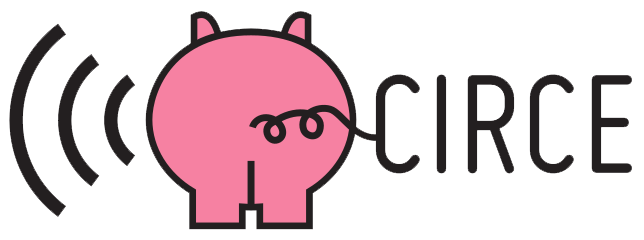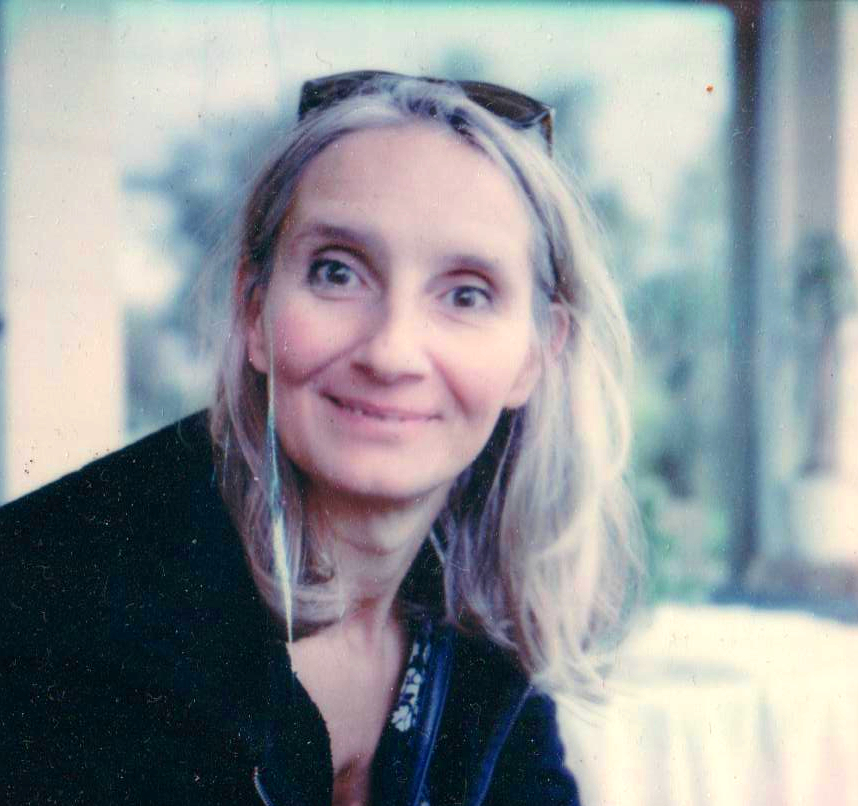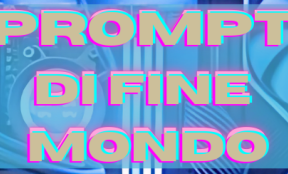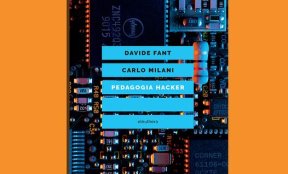The story you are about to read is an appendix to the book Internet, Mon Amour (Ledizioni, 2019, ima.circex.org), a hybrid between an essay and a collection of novellas placed in a speculative science fiction setting: a group of hackers, artists, geeks escape the Great Internet Plague. In a remote place among the alpine valleys, they tell each other stories from before the catastrophe, commenting on them together according to their skills. This is a story about cryptocurrencies, blockchain and non-fungible tokens (NFTs).
It would have been better if I kept on drawing
Bart, 40 years old, the last 15 spent day and night in front of the computer. At night he creates while during the day he is held hostage by a salaried job as a graphic designer at a State Agency. It’s annoying but it guarantees him a roof over his head and a full fridge.
Bart works 8 hours a day, designing brochures, layouts for green washing publications, posters for institutional conventions. Eight hours that he spends at his desk in a grey ministerial office surrounded by colleagues who are waiting for the end of working hours to really devote themselves to their interests. Some play in a heavy metal band, some go to Pilates, some run home to cook and others, like him, love to indulge in the thrill of creativity freed from the chains of commissions. So night after night, year after year, Bart plunges into darkness of his studio, his face illuminated by the blue glare of the monitor, the graphic pen like an extension of his fingers, on the screen the dance of ghostly visions, dreams that come out of his unconscious and manifest themselves in the form of digital collages, cut-ups, vectorial drawings and three-dimensional environments. Bart is very satisfied with his art, he couldn't live without it, it reconnects him with the world and it doesn't matter if, apart from a small circle of friends, nobody knows his artworks.
Bags under the eyes, paleness. The signs of the long hours spent at the computer, now that Bart has turned forty, are beginning to show. It would be nice to go to sleep in the morning and not have to get up after two hours. It would be nice to have the whole day available to continue creating without having to devote oneself to boring covers of books that no one will ever read. But how else to make a living? It's a great fortune to have a job, even if it's precarious.
Earning a living as an artist? Yes, it would have been nice in an ideal world, but the art market is not for him. The art dealers that his caring friends have introduced him to over the years have never shown much interest in his creations: "They don't have a market", "Realism is very popular today, do you have any Hopper-like compositions?", "Beautiful but not in our target." "Yiich, too disturbing" "Thank you, we'll contact you again".
He has had a few exhibitions in underground garages or in places totally outside any commercial circuit frequented only by people like him. He has obtained great satisfaction in terms of criticism. Some visitors have flashed in front of his paintings, others have thanked him, others have photographed his graphics with a smartphone and then used them as profile photos on their social accounts. But nothing more. And that's fair enough for him.
One day Giusy, a friend of him and one of his most convinced supporters, calls him on the phone:
"I have a great idea Bart: the NFTs!"
"What?"
"The NFTs! The new trend in the digital art market! Finally, you can become your own entrepreneur, sell your digital artwork and become filthy rich! Maybe you'll even become part of a digital museum, are you ready to be a player in the New Renaissance?"
"What are you talking about, a great idea for what? I don't know anything about these devilish digital things."
"But everyone is talking about it!"
"Eh but you know I don't watch TV, I don't have socials..."
"Okay, okay, I'll explain: the dozens of digital works you've created can now be sold online and make a lot of money."
"Selling a file? Who's going to buy it?"
"No, you sell ownership of that file! There are collectors all over the world ready to buy that certificate of ownership!"
"Whatever, it's like selling a painting in a gallery, but if nobody buys my paintings why should they buy ownership of my file?"
"Because that's where the market has moved now! You really don't know anything about it? At the end of the second quarter of 2021 NFTs was already a $2.5 billion industry, it's OK you're an artist, always with your head in the clouds... but you should inform yourself a little more after all it's about you too... think about it: just a few clicks to earn unimaginable amounts of money, you'd be free to finally quit your job and dedicate yourself to your art!"
"OK, but I'm not good at this stuff...really,"
"...it's easy, besides I already bought a bundle of Goatseum, I'll send you the link to the platform where I started, there's the guide to create your NFTs step by step, promise me you'll watch it..."
"Okay, okay... I don't know what you're talking about, but okay."
Maybe, who knows, it wasn't such a bad idea, maybe he would finally be able to be recognized by the art world, to earn a living with his artworks. So that night Bart, instead of drawing as usual, opened the link that Giusy had sent him: "How to create your first NFT".
The first laconic piece of information reads: "To create your first NFT you have to subscribe to the platform" fair enough, Bart clicked on the icon of the little guy and on "Create Profile". The second laconic piece of information reads "To use the platform you need an Ethereum wallet." OK... it was already starting to get complicated, what the heck is an Ethereum wallet, anyway let's proceed, this guide should be for dummies, Bart told himself, and clicked on the first "wallet provider" in the list that the platform kindly suggested to him.
"Install the extension on your browser" ah endgame, Bart thought, he hated to install things on his computer for fear that his old but solid Mac would get infected, putting in crisis the whole precarious balance that kept it together.
He closed the browser, opened the graphics program and started drawing. That was enough for that night.
"So?" It was Giusy who hadn't called him in a few days.
"So I gave it up right away, I don't want to get some viruses from the Internet."
"Come on! Still this paranoia! Look it's a safe app, I installed it myself, don't worry, by now everyone is doing NFTs you don't want to be the only one left out of the loop!"
Bart had always been out of the loop, it's not as if being out of the loop bothered him at all... But Giusy was right... he put himself together and installed the extension, trusting her friend.
But it was clear that he couldn't have an empty wallet, he had to fill it with Ethereum, cryptocurrencies, in order to sell his first NFT... what a friggin' business, still he wanted to continue, he had seen all the collections at auction on the platform, some artworks were beautiful, others were embarrassing and yet the "creators" seemed to be selling NFTs... and his artworks were not worse…
So he had to buy some Ethereum, OK, how much will it cost, let's see, 1 ETH = 2,434.01 EUR
WAIT! WHAT!!! Bart yelled. It was almost his entire bank account... no way... But here, he could buy a fraction of Ethereum. Let's see... with one euro he could buy 0.000411 ETH.
Okay, that was all he needed to open the wallet, link it to his profile on the NFT exchange platform. He could afford it. He clumsily proceeded with the transaction, now he was ready to create his first NFT. By now it was morning... in a few hours he would have to go to work... Another night spent without drawing.
For the whole day he thought of nothing else, he couldn't wait to to take advantage of all those sleepless hours and when he got home he quickly accessed his computer again.
He chose one of his works, a scan of an old black and white comic book digitally reworked, he entered the required metadata: title, date of creation, other details that he didn't understand at all... "Now you're ready to freeze your metadata!" Brr... he got a cold chill, he had the feeling he was about to do something irreversible, with an act of courage he clicked proceed and was sent back to a page with blockchain suggestions to "freeze" the metadata of his work, i.e. add his first NFT as a new block to the blockchain: "to mint". In that thicket of obscure terms he recognized only the word Ethereum and selected it. Before his eyes, on the trembling monitor, a new abyss of numbers, codes, incomprehensible words... but in the end he understood that to proceed to the "minting" of the NFT he had to spend 0.0387 ETH, meaning 94.27 EUR. Oh my gosh, whispered Bart. But at that stage he did not want to give up. With 100 Euros he would have obtained 0.0397 ETH, a little more than he needed... but it was getting late, he postponed the demanding transaction to the following evening and took a shower.
The next day, after dinner, well refreshed, he put himself back at the computer, but... surprise, now with 100 Euros he would have obtained only 0.0354166 ETH which were not enough for this damn minting! Yikes! So annoying! Okay, another 10 Euros will do. He proceeded with the transaction, now his wallet amounted to 0.0394897 ETH. Perfect! He went back to the minting menu but... another surprise! Now his first minting was costing 0.0396 ETH. But how is that possible! Bart became impatient. He couldn't believe it. He hurried to buy another 2 Euros of Ethereum before the values fluctuated again and finally got the amount he needed to insert his first NFT in the blockchain.
Now he was ready to put it up for sale. But he really wanted to sleep. He would do it the next day.
"Hi Bart," chirped a cheerful voice behind him. Giusy had dropped by to see him at the office. "So, have you made up your mind with the NFTs or are you still afraid of getting infected? What circles under your eyes! You've been drawing all night haven't you? You have to show me your latest stuff!"
"If only I have been drawing! I've spent the last few nights unravelling this NFTs thing, damn you, you put a bee in my bonnet, I mean, I created my first NFT for one of those black and white comic books manipulations..."
"Ah great, with those you can create a whole collection, a bundle! Brilliant!"
"Actually I still have to put it on sale and this little game already costed me 112 Euros… I don't think I'll create any more NFTs."
"But you'll see! Once you'll sell it you'll start uploading the other scans too!"
"In the meantime, I'd like to, at least, cover my expenses."
In order to cover the expenses, Bart had to set the price of his first NFT at 0.047744 ETH, i.e. 130 EUR, in fact there were also the "commission" costs to be calculated, fees of the platform. But that wasn't the end of it. "If you have never sold on this platform first you need to initialize the wallet." OK, what does that mean? Simple another gas fee, a one-shot commission. Needless to say Bart's discomfort as he had to go back to buying more Ethereum crumbs to proceed with this umpteenth payment. He felt like a stupid. He couldn't wait to get out of it. He set the auction deadline three days later and went to sleep.
Three days later his beautiful digitally manipulated scan of a black and white comic book whose property was for sale for only 130 Euros stood alone on a white background. The interface told him a laconic: 0 bids, 0 saved item, 0 hits. Auction ended.
But how!!! A deep disappointment gripped Bart's gentle soul. It's not possible! But why didn't anyone even see it! It couldn't be like that, it was a matter of principle, he decided to reopen the auction for his first NFT, okay, other expenses, other acquisitions of ETH that meanwhile continued to rise and the work was back on the market, this time for six days.
"Of course no one has seen it!" said Giusy to him over the phone. "You have to promote it, do marketing, get it out into the communities, otherwise how do you think it gains visibility!"
"But I..." stammered Bart, "But marketing is not my thing at all, otherwise I would have already found some gallery or some unhinged collector to buy my works..."
"I got it, I got it," said Giusy, "You know I'm very active in communities, since I bought a stake in the Museum of the New Digital Renaissance, I have so many contacts!"
At the end of the six days the situation was almost unchanged 0 bids, 0 items saved, 18 hits. Auction concluded. He called Giusy:
"I''m done. I stop here, I've wasted 140 Euros but that's enough, six days, 18 visits and no buyers, It would have been better if I kept on drawing."
"But you had 18 visits! Aren't you happy? My marketing strategy worked! I invested 0.008 Ethereum in it, but, I mean, it's crumbs: for you this and more."
"Let me see, what does it amount to... You spent 20 euros!? To do what?"
"To promote the link to your profile in community platforms."
"Great so we're up to 160 Euros in expenses. Great. Look: I quit."
"No, no, no, don't do that! I swear I invest in you, the sponsorship went well! You got 18 hits! I'm going to sponsor it again now, but you should reopen the auction for at least one month!"
More commissions, more Ethereum to buy... in the end Bart put his work up for auction for six months starting from a base auction price of 0.21 ETH, that is 500 EUR, it was what he needed to get back all that madness, and then to give some money back to Giusy... But he was struggling to believe.
After five months (he didn't think about it anymore and started drawing again, even if that shortfall of hundreds of Euros had weighed on his meager finances), suddenly and unexpectedly, the notification from the NFTs platform: "Congratulations! Your first NFT has been sold at a cost of 0.22 ETH!"
"Oh but that's fantastic" Bart was all excited, unbelievable! He had managed not to take a loss! First NFT yes, but also the last, he said to himself, and hurried to update his wallet and convert it to Euro to replenish his sad bank account. But one more surprise was waiting for him on the threshold of the real world... Ethereum had collapsed... The conversion rate of the moment was clear,
:
clear: from the unfavourable exchange rate he would get only 213.37 EUR, minus the transition fee, 197.32 EUR. In all.
What to do now? Maybe it was better to hold on to the Ethereum while waiting for a more favourable conversion rate... Yes. Better to wait. He would have checked the fluctuations from time to time to catch the right moment. Who knows if the value would go up in the future, and how?
To Understand
The question that Bart asks himself at the end (or in the middle?) of his unfortunate adventure in the world of NFTs and cryptocurrencies is not a trivial one, indeed it is the question that many are asking themselves, from the creator of Ethereum, Vitalik Buterin, to the most unscrupulous speculators like Metakovan and Justin Sun who performed one of the most expensive operations in the world of NFTs buying the work Everydays - The First 5000 days by Mike Winkelmann, aka Beeple.
And guess what answer they gave themselves? Easy: Ethereum goes up if people buy it. And how do we get them to buy it? Ah, we have to create something that can only be bought with Ethereum and we have to show that it's a cool thing that everyone will want because we will be the first to buy that kind of thing with lots and lots of Ethereum (we have a lot of them and we don't even know what to do with).
So the answer should now be clear to all of us: Ethereum goes up if clueless dummies like Bart and Giusy start converting Euros into Ethereum. A pyramid scheme as old as the pyramids.
The sysadmin says:
In the 1920s, the blockchain was believed by techno-enthusiast to be a salvific and providential technology that would save mankind from wrongdoings and corruption by replacing the trust that should be built between people through politics, with an irreversible and extremely expensive automated technological process in terms of energy consumption. The blockchain is a database, a way of storing data, which however instead of being encased in a shelf are chained together sequentially, each new piece of data adds to the chain and there is no way to modify that chain except by adding another block that declares that the block in question is no longer valid. This database doesn't just reside on one computer but on all the computers that participate in the blockchain, so each computer has a copy of what is on the other and every time a new block is added everyone has to verify that this really happened by going through a calculation that, once solved, aligns each blockchain with the others. Computation is a massive thing. It requires a lot of energy, and the blockchains most in vogue at the time consumed as much as a state the size of the Netherlands.
The digital artist says:
Yes, but as we read in blog posts of those times, "in blockchain technology the artist sees an opportunity to build a socio-technological system that makes it easier to live off her creative work." We need to put ourselves in the shoes of those poor creatures. Things used to be quite different from today. Now we have learned to value and respect people regardless of the economic value they create. Of course, we had to go through the Great Plague.…
The philosopher says:
The grand illusion that complex processes such as relationships, politics, and trust could be replaced by incomprehensible automated machine processes was one of the causes of the Great Plague of the Internet. From within a system one cannot determine the veracity of claims about the outside of that system. In computer science this is called the "Oracle Problem": interfaces must be created that translate the real world for the computer, but can we trust those interfaces? Who will have written them? How and why? The belief that one can control the real world by putting references to objects and relationships in an immutable, add-only data structure gives one the chills, much like those Bart felt in "mining" his first NFT.
Yet the idea that one could exchange services of all kinds, shares of knowledge, systems of governance, just by coining NFTs, led millions of individuals to coin themselves to exist in the most fashionable virtual worlds.
Financialization of life, the thinkers of the time called it. Many voices were raised to stop this false progress but human greed, combined with the naivety of those like Bart and Giusy, who unfortunately were the majority, led to the global collapse. Financial bubbles exploded leaving the rich richer and the poor poorer, climate disasters caused mass migration and famine. The power was more and more centralized in the hands of those who could afford higher and higher computing power to feed huge blockchains, obviously in defiance of decentralization, since to mine Ethereum or to mint NFT needed very expensive machines as well as technological skills increasingly difficult to acquire.
The geek says:
If it seems strange to you that the transactions Bart was making to "mine" NFTs fluctuated so much you have to think that the cost was tied to the amount of transactions a blockchain was already engaged in. So to the workload currently being performed. And to get an idea of the computing power required:
"… adding transactions is just ridiculously slow. Bitcoin currently can do about 4.5 transactions a second. FOR ALL OF BITCOIN. Ethereum is a little better and can do about 30 transactions a second. That is ridiculously low. The VISA network to process credit cards can do up to 24000 transactions a second (they currently do about 1740 a second). Try that number on for size." (The Third Web, Tante@tante.cc, CC-BY-SA 4.0)
The entrepreneur says:
You didn't understand many of the words in the story, did you? Don't worry, in those days it was a very common technique to make the neophyte feel ignorant and to put him or her in a condition of subjection ready to accept any condition. NFT, to mint, gas fee, to mine, smart contract, acronyms like DAO and so forth. Wouldn't some alarm bells have rung? Follow your intuition, if you really do not understand what we are talking about, it is likely that we are talking about scam to trick you.
A word to us:
There were some technologies, not different from others, that were simply following other paths, technologies developed to strengthen the relationships between realities, to make us enjoy beautiful things, to be together, to create works, to work with precision. Convivial technologies imagined and written by people who didn't care about getting rich, who didn't care about making a profit and who didn't think that freedom coincided with the freedom to buy and sell.
Pay attention to the world you imagine, turn your attention away from the sirens of the marketplace and come listen to the gentle wind blowing in the Third Infoscape.
Please note
In this story the conversion value of Ethereum is for February 19, 2022 and calculated at https://changenow.io/. Fluctuations are speculative
Bibliography:
- Tante, The Third Web, tante@tante.cc, CC-BY-SA 4.0
- Salvatore Iaconesi, Riflessioni sugli NFT a margine di un articolo di Alessandro Baricco
- Felix von Leitner, Critique of NFTs and "Web3", https://blog.fefe.de/
- NFT marketplace, https://opensea.io/
- Mike LaTour, Selling NFT art - why you as an artist should be selling NFTs: https://soundwaveart.com/selling-nft-art/
- Ben Davis, The Buyers of the $69 Million Beeple Reveal Their True Identities—and Say the Purchase Was About Taking a Stand for People of Color, https://news.artnet.com/art-world/beeple-buyers-metakovan-twobadour-1953418
- Ben Davis, I Visited the Digital Beeple Art Museum and All I Got Was an Aggressive Pitch for My Money, https://news.artnet.com/opinion/beeple-b-20-museum-review-1954174
- Folding Ideas, Line Goes Up – The Problem With NFTs, https://youtu.be/YQ_xWvX1n9g
- Brad Troemel, The NFT Report, https://youtu.be/PXBxVFsHBJQ
Creative Commons Attribution - NonCommercial-ShareAlike 4.0 CC BY-SA 4.0



